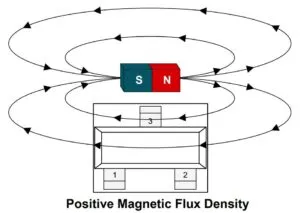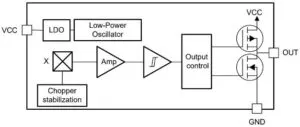That said, it is only just ahead of the similar 1.5mT in-plane Hall switch introduced by Melexis last week, which also has an internal magnetic concentrator.
The TI unit, TMAG5134A1CDBVR, is part of the seven member TMAG5134 family aimed at simple applications such as door and window sensors, personal electronics and home appliances.
 “In-plane sensing capability enables it to detect magnetic fields parallel or horizontal to a printed circuit board, giving engineers design flexibility,” according to the company.
“In-plane sensing capability enables it to detect magnetic fields parallel or horizontal to a printed circuit board, giving engineers design flexibility,” according to the company.
The multiple versions give a choice of threshold sensitivity and sample rates: ±1mT (10Hz), ±1.3 (1.25, 5 or 20Hz), ±1.5mT (10Hz) and ±2mT (20Hz).
 Output is a single CMOS type which is high between the thresholds and low outside them (which TI calls ‘omnipolar’) – around each of the thresholds is 0.4mT hysteresis (diagram right).
Output is a single CMOS type which is high between the thresholds and low outside them (which TI calls ‘omnipolar’) – around each of the thresholds is 0.4mT hysteresis (diagram right).
A single device in the family comes in a 0.9 x 1.3mm four-pad LGA (instead of 2.9 x 2.8mm SOT-23 for the others) and has two outputs which separately implement the left and right sides of the graph above, and remain high in the ‘other’ quadrant – ‘dual-unipolar’ in TI speak. It has ±1.3mT thresholds and a 20Hz sample rate.
Beyond these are special order configurations with a choice of: inverted outputs, open-drain outputs, sensitivity down to 3mT, and sampling up to 8kHz.
Average consumption is 500nA for 1.25Hz updates, 600nA for 5Hz, 900nA for 10Hz and 1.4µA for 20Hz.
Operation is over 1.65 to 5.5V and -40 to +125°C.
For development, there is an an evaluation module and TI’s Magnetic Sense Simulator tool.
The Hall switches are made in TI’s own fabs on 300mm wafers.
Find the TMAG5134 family on this TI web page

